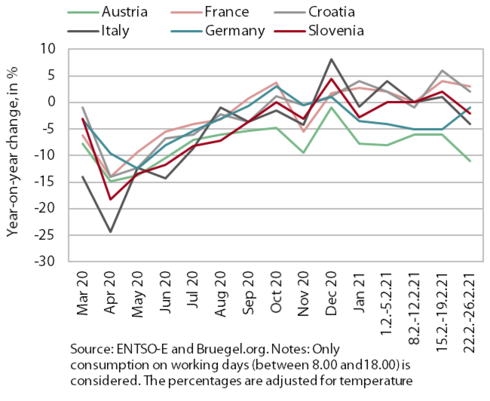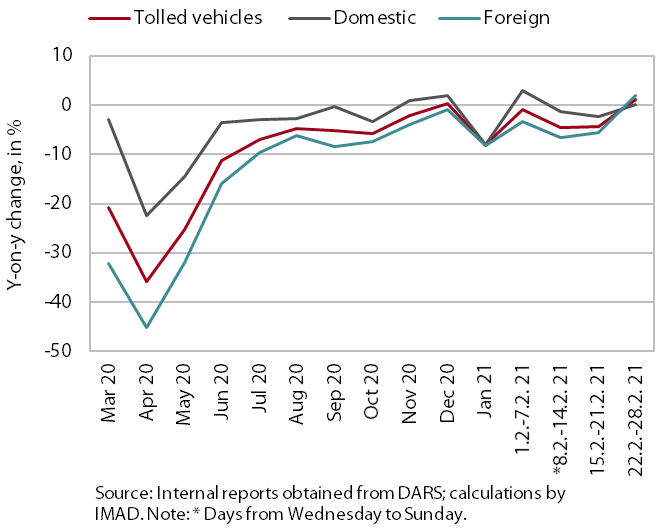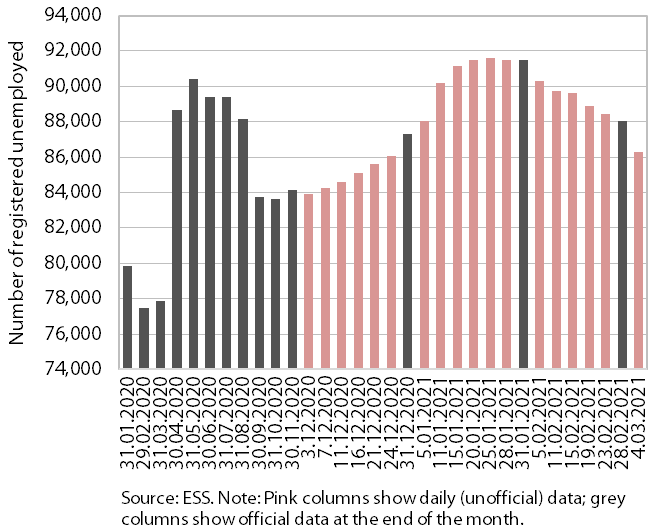Charts of the Week
Current economic trends from 1 to 5 March 2021: electricity consumption, traffic of electronically tolled vehicles and registered unemployment
The indicators of current economic activity available for the end of February and the beginning of March remain relatively favourable. Electricity consumption, which was similar to last year’s for the most of February, was otherwise somewhat lower year on year in the last week of the month. In contrast, freight traffic on motorways was even higher than last year. The number of registered unemployed persons decreased further at the beginning of March – at the end of February, it was up 13,6% year on year mainly due to a rise during the first wave of the epidemic.
Electricity consumption, February 2021

Electricity consumption, which was roughly unchanged year on year in the first three weeks of February, fell by 2% year on year in the last week of the month. In Austria, the y-o-y decline in consumption deepened from around 6% to 11% two weeks after the partial relaxation of containment measures and was almost the same as at the beginning of the second wave of the epidemic. In Germany, the y-o-y fall in consumption (1%) was the smallest since the beginning of the lockdown. In Italy, consumption was again down year on year after several weeks (4%), while in France and Croatia, it was 2% and 3% higher respectively.
Traffic of electronically tolled vehicles on Slovenian motorways, February 2021

Freight traffic on Slovenian motorways in the last week of February was 1% higher than in the same period last year. Between 22 and 28 February, domestic vehicle traffic was unchanged year on year, while foreign vehicle traffic was 2% higher. In year-on-year comparison, there is some effect of a lower base, as traffic had already declined slightly before the declaration of the first wave of the epidemic. At the same time, traffic was very high at the end of this February. In February, it otherwise remained lower year on year (by 6%), which is also related to one less working day this year.
Registered unemployment, March 2021

The number of registered unemployed persons has been falling seasonally since the end of January. The adoption of intervention measures to preserve jobs during the first wave of the epidemic and the subsequent easing of restrictions on businesses stemmed the high unemployment growth in May last year. From July to September, the number of unemployed persons was thus gradually falling and maintained a similar level until the end of November. With intervention measures still in place, the increases in December and January did not deviate significantly from seasonal increases in the same period of previous years. The seasonal decline in the number of unemployed, which started at the end of January, continued in February. A fall was also observed at the beginning of March. Overall, 86,309 persons were unemployed on 4 March according to ESS unofficial (daily) data, which is 2% less than at the end of February and around 11% more than in the same period last year.
